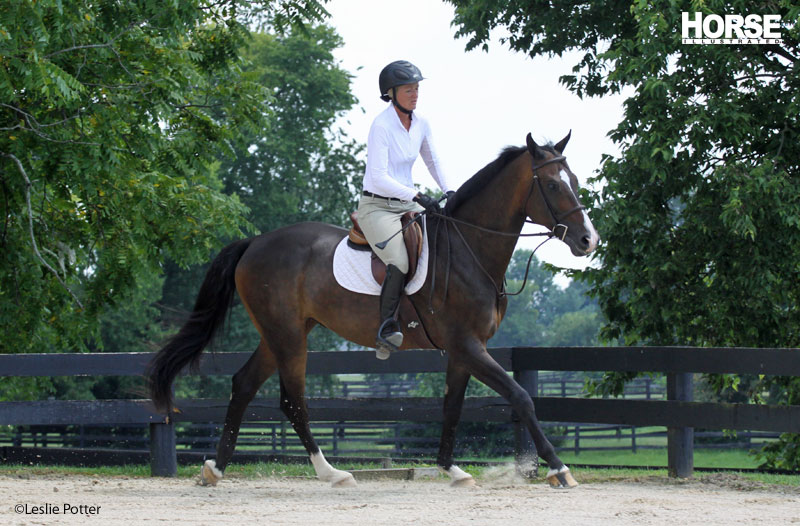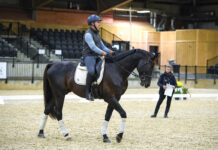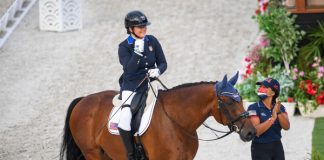On-the-aids goes out the window when you ask for canter. Your horse trots faster and faster until he finally plunges into canter, which he maintains only for a few unbalanced moments before he falls back into that equally not-fun-at-all runaway trot. The whole exercise makes you feel bounced around, out of control and disheartened.

Young or green horses simply don’t have the strength to hold themselves in a rhythmic canter, Ashley explains. A horse’s body easily maintains balance in trot since the horse moves in diagonal pairs in this gait. But canter is a three-beat gait. This means the horse’s entire body weight bears down upon the outside hind leg when it steps off into the first beat of canter.
“You’ve got to give a horse time to build the strength he needs to hold himself in canter,” explains Ashley. “It won’t happen overnight. And you’re not doing you or him any favors by allowing your horse to canter badly. Use transitions and schooling figures to improve the quality of your horse’s canter.”
Use the Trot to Improve the Canter
“Be willing to accept the notion that you can’t fix the canter within the canter,” says Ashley. “Right now your green horse isn’t strong enough to sit down on his hocks and carry the weight of a balancing half-halt within canter.”
So, here’s the philosophy you’ll use to guide your canter work for the next few months. Use trot as your half-halt. Look for short moments of quality canter; as soon as the canter begins to deteriorate go back to trot, regroup, and then try canter again.
“There’s no better way to improve your canter than to focus on trot-canter-trot transitions for weeks and weeks, if not months, depending on your horse’s age and level of conditioning,” Ashley suggests.
Exercise 1:
To start, establish a large working trot circle in your arena—usually 20 meters, or the width of your arena, works fine. Most horses—like people—prefer one side to the other. Always start in the direction of your horse’s easier lead.
Now, ask for canter and remain on the circle. Staying on a circle will encourage your horse to carry himself, since he has to shift weight to his haunches in order to turn; bending him on the circle will also help your horse stay soft in the bridle. Keep your shoulders tall and stay centered in the saddle, even as your hips follow the motion of the canter. Don’t give your horse your arms to lean on by pulling back on the reins, Ashley warns. Keep a soft contact, and follow the motion of your horse’s head and neck at canter with pliable arms and elbows. Even if your horse seems heavy in the bridle, keep your contact light. The horse must learn to balance himself—you can’t do it for him.
The instant the canter gets unbalanced or hurried, go back to trot and immediately half-halt. Never allow your horse to run in trot after canter. If your horse rushes his trot, simply move onto a smaller circle to encourage him to slow down. Then move back onto the larger circle. At first you may only be able to canter halfway around your circle—that’s fine. Remember, you’re looking for quality canter work. This may be an entirely new concept to your horse; give him time to understand what you’re after.
It might take an entire circle to re-establish a rhythmic trot. That’s OK, too, for now. However, expect your horse to obey your corrections within trot—after all, this is something he already knows. Once you’ve repeated this exercise a few times, he should come back to a steady trot right after the downward transition. (If he doesn’t, consider adding a “wake-up call” correction, like a trot-halt transition.)
Once you’ve regrouped in trot, go back to canter and repeat the exercise. Try this several times in one direction, then repeat in the opposite direction on the horse’s other lead. For your first session, you may only succeed in riding half the circle in a quality canter, and you might need an entire circle in trot before you canter again.
Over time, repeat this exercise, gradually lengthening the time you stay in the canter and shortening the duration of your trot corrections.
Preparing for the Canter Half-Halt
As weeks pass and your canter work improves, your horse should be able to maintain several circles of quality canter before you go back to trot. By now your horse should also be quite sharp to these upward and downward transitions, easily moving back and forth between the two gaits.
Now, Ashley explains, it’s time to introduce some more exacting canter-trot-canter exercises, as a way of preparing your horse for an eventual half-halt within the canter.
Exercise 2:
First, add a change of direction into the scenario by riding a canter-trot-canter figure-eight. Ride a 20-meter trot circle at one end of your arena. Now canter the circle and return to trot, but change direction as you turn across the center of your arena. Trot the same-sized circle in the opposite direction, then canter it. Repeat the exercise, so you’re changing leads after a full circle of trot in each direction. Once you’ve mastered the figure-eight, see if you can eventually change leads through shorter and shorter periods of trot.
Exercise 3:
After several successful figure-eights, try a big, three-loop serpentine, using your entire arena. First trot this figure several times, so you’re comfortable riding these sweeping curves and changes of direction. Now trot a 20-meter circle at one end of your arena. Pick up the canter on the short side of the arena, and canter your first serpentine loop. Trot as you straighten out the curve across the center of your arena; then pick up the canter on the new lead as you make the turn into your next loop. Then repeat for the third loop, and return to trot once you’ve finished the figure. Again, gradually try to shorten the number of trot steps you need to change leads between the loops.
Exercise 4:
For the next exercise, you’ll use your entire arena. Establish a 20-meter working trot circle at one end of your arena, then canter the circle. After completing the circle, ride a downward transition to trot as you turn into the corner of your arena and trot a 10-meter circle in that corner. Then return to canter down the long side of the arena, and trot a 10-meter circle in the next corner. Repeat this around your entire arena. If you feel this is too difficult, you can ride each 10-meter trot circle twice in order to give yourself a little more time to regroup between the canter sessions.
Introducing the Canter Half-Halt
Exercise 5:
After weeks, if not months, of progressive training, you should be able to introduce a half-halt within the canter.
Go back to your tried and true canter-trot-canter exercise on the 20-meter circle (Exercise 1), but this time, trot half the circle, then canter the other half. (By now your horse understands these transitions, and he should be able to easily handle this exercise.) Practice these precise transitions over and over, then gradually shorten your trot sections of the circle, so you are cantering for three-quarters of the circle, say, then trotting only for a quarter. Then work to the point where you trot for only three steps on the circle before returning to canter.
Now, stay on your circle, ride canter and prepare to trot. Maintain a soft supporting leg as you lift up your rib cage and brace your back to ask for the half-halt. At the same time let your elbows softly come back, and put a little drag on the reins as though you mean to trot. But at the instant you feel your horse respond to your downward request by shifting his weight behind as though he will trot, add more leg, soften your fingers and keep cantering. (You should feel like you’re asking your horse to canter in place for a step or two.) Continue in canter.
Make sure you intersperse these early canter half-halts with downward trot transitions, so you’re constantly reinforcing this new concept with one he already understands.
“Whether you plan to jump or ride dressage, the canter half-halt will become a very important tool in your future training,” Ashley explains. “Give your horse all the time he needs to understand this concept and gain the strength he needs to accomplish it. A 4-year-old probably won’t be strong enough for a canter half-halt, but if you spend a year working on canter-trot transitions, he’ll be well on his way to perfecting the canter half-halt as a 5- or 6-year-old.”
Further Reading
Learn to Roll with the Canter
In Transition
How to Sit the Canter
Annie Eldridge trains young event horses out of her Setter’s Run Farm in Duxbury, Mass., and is HI’s English Training Talk columnist.
This article originally appeared in the July 2004 issue of Horse Illustrated. Click here to subscribe.







This is a very helpful article. I had heard parts of this idea, but it is good to see the steps and the purpose all in one article. Thanks
This article was very useful. I just began riding a green horse, who has problems cantering as she is very unbalanced, so I will definitely try some of these exercises.
wow. this was extremely helpful. im definately trying these excercises.
good article
This was EXACTLY what I was looking for. So well written, and incredibly informative as to the how and why.
Thank you!
I’m going to try this. My daughter has a paint gelding that just turned 6yrs. and still doesn’t have a balanced canter.
My 6yr old foundation App.will not lope on the right lead…When i ask him to canter..he throws his head up & around & when i push him on he just stops..I have ben working him now for 2 months & his getting to the point were he just does not want to canter at all…..what is wrong ??
Cindy: It could be that your balance/seat are the problem. This may sound harsh, but I have reason to believe that about 98% of training issues are the rider’s fault, not the horse’s.
Maybe you used to tense up and slam into the saddle as soon as he started cantering, causing him to stop, and by now he’s reluctant to even try, because it’s hurts. (I have that problem, unfortunately).
It could also be that his saddle/back/something else hurts when he canters, and the pain is, again, not worth it to him.
If this gets worse, you should contact a pro trainer to check it out and work on him before he’s ruined.
…Hi…very helpful article…thanks so much !!!
Thank You for this awesome artcle! I finally understand clearly how to correctly train my Friesian to canter on his own balanced and collected ~ Yea!
This was a great article, but I have a specific question, when me and my horse canter, she picks it up nicely and can switch her leads, but it’s SUPER long and we can’t dream of circling while cantering. Any suggestions?
very informative will put this into practise as my horse goes really forward in trot but does hate the canter sofar will keep trying and get back to you in a few months after a lot of hard work
good article but i wish they would have told how fix some of the riders canter problems…
Excellent article, will follow instructions my Sports Friesian, Zephyr. Sure will work!
Awesomee, thanks for the info, time to get my 8 year old cantering successfully! should have been done a long time ago but he wasn’t broke until 6 and wasn’t ridden by me until 7.
I’m feeling really confident about this now, rather than feeling discouraged like I did before!
Great article. I love how it provides step by step instruction.
This is an informative, well-written article! I have tried this method for two weeks and am already seeing results with my green Morgan. I’ll continue this method for the rest of the winter and spring. Thank you so much for the help!
This is a really helpful article, just what I was looking for.The information is clear and precise and I look forward to trying these techniques with my 6 year old very green mare!
This article was so amazing. My greenie has such a balanced canter and enjoys these exercises!! Thanks!
My horse has benefited from this emmensly! Thanks!
i disagree a bit with the author. to canter well the horse first has to learn how to use his neck to balance. no green horse will be able to rock back on his hocks; that takes a long time to develop.
leg-yielding followed by a canter transition is a great way to work on the depart itself, as it sets up the hind leg that takes the first canter step for the depart.
working on the transition and the quality of the canter are to different things. to work on the canter itself, first establish good stretching at the trot, and then canter from there. give your horse his head so that he learns that HE is responsible for his balance. he may break a few times, but will pick it up quickly. it’s ok if he’s on the forehand; in fact, it’s impossible for him not to be at this point. also, never sit the canter on a green horse; get up into half seat.
working at the walk can also help improve the quality of the canter.
Good advice.
I have never heard someone say ” use his neck to balance” and that’s very misleading. Balance and collection comes from top line and forward movement, not just the neck curved. The author does say that this will take a long time. People who rush into collection get fake results.
A horse uses its head and neck to balance itself in walk and canter that’s why we must go with the horse through our shoulders and arms.
It would be great if I could read the txt, it’s far too small, and u have to keep zooming in to read it and u then un zoom to read the left and right hand sides, then rezoom in, annoying which is a great pity cause the article is good but it’s too difficult to read!
Really helpful!!
Upon cantering my horse he suddenly comes to a halt and firmly plants his front legs downward – sometimes throwing me forward onto his neck. Scary and I really need some suggestions (help!) with this recent problem.
Thanks!
I have recently rescued a 16yr old Welsh cross, he is a very willing pony and is always trying. However I cannot get him to canter without him becoming terribly unbalanced leading to him bucking. I have been working on his trot, in circles and pole work and if I’m honest am becoming too nervous to ask for canter in case he throws me off. I was going to in the school the other day but his trot just becomes faster and he may give me on or two strides before possibly bucking. His back has been checked, and his saddle. Any suggestions please?
Fantastic article. I have one more suggestion to help a horse improve his canter and that is to canter him uphill on trails to strengthen his rear motor. It’s easier for you to balance over his withers to help him at this time too. I have a part Friesian and he has been challenging in this area.